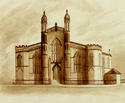 Episcopalians, who used a prayer book and bishops in authority, all but disappeared in Glasgow after 1688 largely because they were suspected of Jacobite allegiances. Adam Cockburn attempted to read the English service over a soldier's grave in 1712 and was expelled from the churchyard by the mob. At about the same time Alexander Duncan opened a chapel off the High Street, but was forced to move to a private house in 1728. More determined attempts to establish Scottish Episcopal congregations were made from the 1770s, particularly by Alexander Jamieson from near Montrose, who led his flock from a room in the old Grammar School until 1823.
Episcopalians, who used a prayer book and bishops in authority, all but disappeared in Glasgow after 1688 largely because they were suspected of Jacobite allegiances. Adam Cockburn attempted to read the English service over a soldier's grave in 1712 and was expelled from the churchyard by the mob. At about the same time Alexander Duncan opened a chapel off the High Street, but was forced to move to a private house in 1728. More determined attempts to establish Scottish Episcopal congregations were made from the 1770s, particularly by Alexander Jamieson from near Montrose, who led his flock from a room in the old Grammar School until 1823.
 There were always English residents in the city, particularly soldiers stationed at the barracks. In 1750 St-Andrew's-by-the-Green was built to serve their needs under the jurisdiction of the Archbishop of York. Known as the "whistling kirkie" on account of its organ, it survives as an office and is the oldest Episcopal church building in Scotland. Jamieson's congregation refused to join St Andrew's and built a chapel off Renfield Street in 1825, called St Mary's, with seating for over nine hundred. In 1871 the church moved to Great Western Road and in 1908 became the Episcopal cathedral.
There were always English residents in the city, particularly soldiers stationed at the barracks. In 1750 St-Andrew's-by-the-Green was built to serve their needs under the jurisdiction of the Archbishop of York. Known as the "whistling kirkie" on account of its organ, it survives as an office and is the oldest Episcopal church building in Scotland. Jamieson's congregation refused to join St Andrew's and built a chapel off Renfield Street in 1825, called St Mary's, with seating for over nine hundred. In 1871 the church moved to Great Western Road and in 1908 became the Episcopal cathedral.
With the influx of Irish emigrants, many of whom were Episcopalians, to work in the textile trades, missionary efforts were made in the East End and on the South Side supported by sympathetic north Lanarkshire and Renfrewshire gentry families. Most of these failed with the exception of Bridgeton where Christ Church opened in 1835 under the inspired leadership of the Reverend David Aitchison. Unlike other parts of Scotland, Episcopalianism remained fragile in Glasgow with congregations composed largely of incomers.